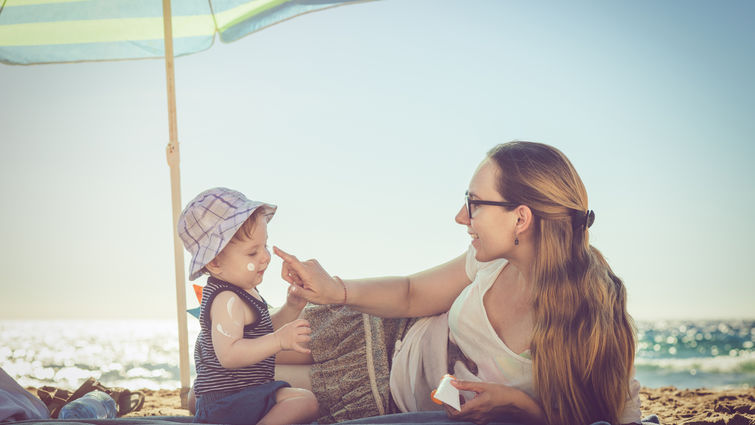
There’s nothing quite like fun in the sun with your family. But Alexandra Clark, MD, division chief of general pediatrics and pediatric hospital medicine for Loma Linda University Children’s Health, reminds parents to be aware of sun safety for themselves and their kids.
“Our primary source of UV light is actually from the sun,” Clark says. “It’s an important element that helps our bodies create vitamin D in our skin, but we have to be thoughtful about how much exposure we get.”
Sunburns are caused by invisible UV rays, says Clark. Both UVA and UVB rays can cause skin cancer. Apart from skin cancer, prolonged, unprotected exposure of our skin to these rays can cause skin damage including tanning, burning, wrinkling and skin aging.
“The risk of skin cancer begins during childhood,” she says. “We are encouraging children to be outside playing because that’s really healthy for them. But if we do that without protecting their skin from UV radiation, we increase their risks that as adults they will develop different forms of skin cancer, most commonly, basal cell carcinoma and melanoma.”
Here’s how Clark recommends protecting your child:
1. Save the outdoor activities for before 10 a.m. and after 4 p.m.
- “Some sunlight is very good, but there are different times of day where we know it’s safer to play under the sun’s rays and that’s when it’s not as strong,” says Clark.
- If your kids are playing outside during the midday, Clark says to remain in the shade as much as possible and layer on other skin protection.
2. Use sunscreen and don’t forget to reapply.
- Clark recommends using mineral sunscreens, including zinc oxide and titanium dioxide types, for young children and children with sensitive skin. These act as a barrier between your child’s skin and the sun, deflecting UV rays from the skin, and are hypoallergenic.
- “Chemical sunscreens, which are liked more often because they’re easy, often spray on, and absorb quickly into the dermis of the skin can be used in older children” she says. “While there have not been a lot of children’s studies to look at how much of that chemical is absorbed into the body outside of that primary layer of the skin, the American Academy of Dermatology has deemed them safe to use.”
- The American Academy of Pediatrics recommends choosing a sunscreen that says “broad spectrum” as it will protect your child against both UVA and UVB rays.
- Children under 6 months old should not have sunscreen applied.
3. Cover up.
- Clark says find shade or bring an umbrella. Put sunglasses with UV protection and big, floppy hats on your kids and babies.
- “There is a lot of great sunscreen clothing on the market,” Clark says. “They’re lightweight but have UVA and UVB protection, long sleeves, and you can get them wet and they will dry rapidly. These are great for everyone but especially those kids under 6 months who can’t use sunscreen.”
So your child gets burned, what then?
“If you notice that, despite your best efforts, your child got a little more pink or red on the skin, apply an aloe product right on the skin,” she says. “That can be from the store or straight from a plant in your home! Aloe is soothing and great for sunburns.”
Clark says parents should monitor their child’s skin for blisters or any severe damage past just pinkness or redness. “If you’re seeing anything beyond that, please call your doctor and at least schedule a video visit,” she says. “Make sure they’re able to assess the extent of the burn on your child and really partner with you to look for secondary damage.”
Clarks says pediatricians absolutely want children and families to get outside and play. “We just want to encourage them to do so in the safest way possible, including both layering protection and minimizing sun exposure,” she says.
Visit our website to learn more about UV safety for kids.
